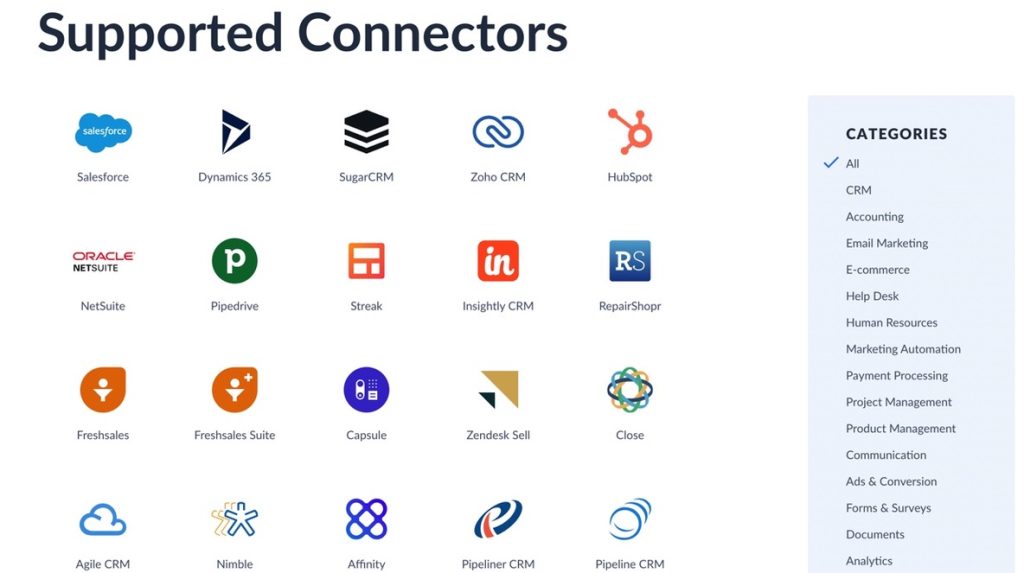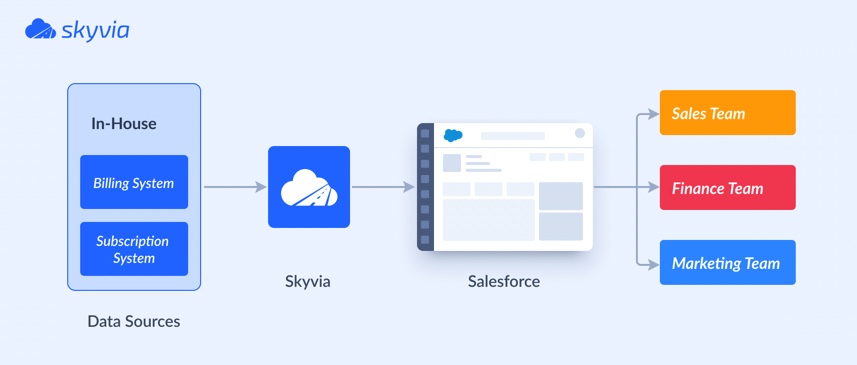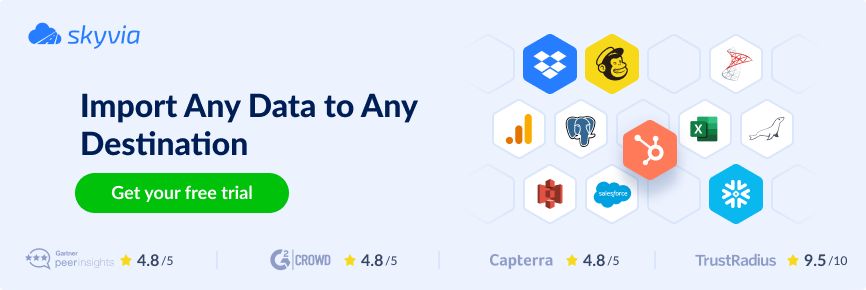Nowadays, the market is flexible and changing fast. Businesses aiming to stay competitive must provide exceptional customer experiences, make informed decisions based on accurate data, and achieve operational efficiency. Data integration platforms, like Salesforce, help solve many critical challenges in this way.
In this article, we’ll discuss why integration data into Salesforce is so important, what benefits it may bring to users, and go through the most successful practices and integration patterns.
Table of Contents
- Understanding Salesforce Integration and Its Importance
- Real-life Examples of Integrating Salesforce with Additional Platforms
- Salesforce Integration Best Practices
- What are the Common Integration Patterns?
- Conclusion
Understanding Salesforce Integration and Its Importance
Integrating data with Salesforce means connecting it with other data sources and systems, like ERP, HR, finance, marketing platforms, etc., automatically exchanging data between them. Companies use many services, making this integration quite a challenge, – so why should businesses integrate data into Salesforce?
- If you need to enhance business operations in the organization.
- If your company wants to elevate its customer experience.
Let’s discover more reasons why data integration is essential.
360-Degree Customer View
Integration consolidates customer data from multiple touchpoints into Salesforce, offering a complete view of customer interactions to personalize:
- Customer service.
- Targeted marketing.
- Sales strategies tailored to individual customer needs.
For instance, businesses can synchronize customer data between Salesforce and an ERP system like QuickBooks or Oracle NetSuite. This ensures sales teams can access up-to-date information on customer orders, inventory levels, and payment statuses.
Integration tools can also automate the flow of support ticket information into Salesforce, helping sales and service teams to collaborate more effectively and resolve issues faster.
Watch the video on how to revolutionize your Salesforce experience and learn how you can automate your business processes.
Streamlined Business Processes
Connecting Salesforce with other systems automates workflows and data exchange, eliminating manual data entry, reducing errors, and saving time.
For example, integrating Salesforce with an email marketing platform such as Mailchimp via data integration tools allows for automatically updating email lists based on Salesforce contacts, facilitating targeted marketing campaigns directly from CRM data. You can also use a Salesforce SMS integration such as Heymarket’s to track all of your text messages in your CRM and trigger texting flows based on your Salesforce data.
Read more on these cases from our articles:
- Stripe to Salesforce Integration: Easy-to-Follow Guide
- Salesforce and ERP Integration
- How to connect Intercom to Salesforce
- Marketo Salesforce Integration: Tutorial Guide
- Shopify Salesforce Integration: 3 Best Methods
Improved Data Quality
Data integration helps the accuracy and quality of data increase because:
- There is no need to enter data into several systems.
- Data isn’t duplicated.
- There is no human factor.
Teams can reduce the risk of data silos, duplications, and discrepancies, ensuring that the business operates on reliable data.
For instance, data integration solutions like Skyvia reduce the complexity of connecting Salesforce with other systems. It offers 200+ pre-built connectors and templates that simplify the integration process, allowing companies to quickly set up and automate data flows without extensive IT resources, boosting productivity.

Scalability and Flexibility
As business needs to evolve, the integration setup can be easily adjusted or expanded to include new platforms or data sources.
Integrating Salesforce with additional third-party platforms means a more connected and advanced business ecosystem. It amplifies Salesforce capabilities, leveraging its CRM strengths while enhancing functionality, scalability, and flexibility, saving time. Honest pay-as-you-go pricing is also a substantial benefit in this case.
Data Security and Compliance
Integrating systems through secure platforms ensures that data exchange complies with data protection regulations. Data integration platforms offer secure data transmission channels and adhere to best practices in data security, helping businesses maintain the confidentiality and integrity of their data.
Real-life Examples of Integrating Salesforce with Additional Platforms
Here are the real user stories showing how integrating Salesforce with other platforms helps businesses in different cases.
Exclaimer improved Salesforce Integration And Transformed Data Connectivity

Background: Exclaimer is a UK-based SaaS company that develops email signature management software. They selected Salesforce as a central data system and the single source of truth for all company departments. However, the fast data generation and integration between ERP and CRM systems became challenging.
Solution: They found Skyvia as a no-code system, providing drag-and-drop UI and simplifying data transfer without additional staff training.
Result: Analysts can connect Salesforce with the local billing system, enabling smooth billing data, AR, MRR, and subscription details flow, benefiting 25-30%.
Cirrus Insight enhanced Salesforce-QuickBooks Integration
Background: Cirrus Insight is a CRM platform integrating Salesforce with third-party solutions, such as Microsoft’s Office 365 and Gmail. They sought to integrate Salesforce with QuickBooks to enhance productivity and reduce costs.
Solution: Cirrus Insight selected Skyvia to help with Salesforce-to-Salesforce and Stripe-to-Salesforce integration and connect with QuickBooks.
Result: This integration improved operational efficiencies, streamlined financial reporting, and saved time and resources, allowing them to focus on critical business goals.
Salesforce Integration Best Practices
Integrating Salesforce effectively into your business processes and systems landscape depends on:
- Business goals.
- Approaches.
- Best practices selection.
Let’s consider the practice checklist and select the ones suitable for your business.
Conducting Comprehensive Planning and Analysis
- Dive deep into your current and future business needs, the data landscape, and system dependencies to identify the integration goals. This step informs the integration project’s scope, requirements, and potential challenges.
Prioritizing Data Security and Compliance
- Ensure that data handled within and through Salesforce complies with laws like GDPR and standards such as ISO.
- Use secure data transmission methods and implement access controls to protect sensitive information.
Utilizing Robust Integration Tools and Platforms
- Use integration platforms like Skyvia, MuleSoft, or Dell Boomi, which simplify complex integration by offering extensive Salesforce connectivity options, providing pre-built templates, and supporting custom workflows. Go here to see a comparison of capabilities.
Implementing Data Mapping and Transformation
- Accurately map data fields between Salesforce and other systems, transforming data into the appropriate formats and structures required for seamless integration and functionality.
Establishing Real-Time Synchronization
- For critical business operations, implement real-time or near-real-time data synchronization to ensure that changes in one system are immediately reflected in Salesforce, maintaining data coherence and operational responsiveness.
Enabling User Training and Adoption
- Tailor training to different user roles, emphasizing the benefits and changes the Salesforce integration brings.
- Foster user adoption through comprehensive training programs and support resources.
Monitoring and Maintenance
- Monitor the integration for performance and errors.
- Establish maintenance routines to update integrations based on new Salesforce releases or changes in connected systems.
Iterative Testing and Optimization
- Adopt an iterative approach to testing, starting small and expanding scope as confidence grows.
- Use feedback to optimize and refine the integration, ensuring it meets evolving business needs.
Embracing Scalability and Future-Proofing
- Design your integration architecture with scalability, anticipating future business growth, data volumes, and new integration points to avoid future rework.
Seeking Expert Guidance and Support
- Feel free to consult with Salesforce integration experts or partners for complex integrations. Their experience can provide invaluable insights, best practices, and troubleshooting support.
Create a Data/Process Integrity Checklist
- Develop a checklist to assess the integrity of data and processes affected by the integration, ensuring ongoing accuracy and reliability.
Review and Refine the Project Plan
- Regularly check your project plan, refining objectives, timelines, and resources in response to challenges encountered and lessons learned during implementation.
Choose a Tool to Help Manage the Process
- Use project management tools like Jira, Trello, Asana, etc., to keep track of tasks, milestones, and documentation, ensuring a coordinated approach across teams and stakeholders.
What are the Common Integration Patterns?
Integration patterns offer distinct advantages and trade-offs, and their suitability depends on factors such as performance requirements, data volume, latency tolerance, and system architecture. You may combine them to address diverse integration needs within your enterprise ecosystems. Let’s review the most common ones and see how Salesforce uses them.
Request and Reply
This pattern means that one system sends a request to another and waits for a response before proceeding. It’s often used in scenarios requiring immediate feedback or a specific response. Examples include API calls, RPC (Remote Procedure Call), and synchronous web service interactions. While this pattern offers real-time responsiveness, it may cause latency and potential bottlenecks, especially in distributed systems.
- Salesforce provides REST and SOAP APIs allowing external systems to send synchronous requests for accessing, manipulating, and querying Salesforce data. For example, a mobile application may use the Salesforce REST API to fetch customer records or update real-time sales opportunities.
Fire and Forget
Contrary to Request and Reply, the Fire and Forget pattern means sending a message or request to a destination without waiting for a response. Once the message is sent, the sender doesn’t expect any response from the recipient. This pattern is helpful for scenarios where immediate response is unnecessary, such as logging, event notification, or non-critical data updates. It reduces coupling between systems and can improve scalability and fault tolerance.
- The Salesforce Platform Events feature provides asynchronous communication between Salesforce and external systems, allowing them to publish and subscribe to events.
- External systems can publish events to Salesforce, such as notifying Salesforce about inventory updates or customer interactions, not waiting for a response.
Batch Data Synchronization
Batch data synchronization periodically synchronizes data between systems in bulk, typically at scheduled intervals. Instead of processing individual data changes in real time, batch synchronization collects and processes large data volumes in batches. This pattern is suitable for scenarios with high data volume, limited bandwidth, or where real-time synchronization is not required. Batch Data Synchronization helps optimize resource usage, reduce network overhead, and improve system performance.
- Salesforce offers tools like Data Loader to facilitate batch data synchronization between Salesforce and external DBs, ERP systems, or legacy apps. Alternatively, you can use more advanced third-party tools like Skyvia Data Integration.
- Companies can schedule data imports or exports to synchronize large volumes of data between Salesforce and external systems at scheduled intervals.
Remote Call-In
A system invokes functionality or services hosted on a remote server or platform. This pattern is commonly used in distributed architectures, where components must communicate across network boundaries. Remote Call-In can involve synchronous (e.g., RPC, RMI) or asynchronous (e.g., message queuing) communication mechanisms. It allows using external capabilities or resources without replicating functions locally, promoting code reusability and modular design.
- Salesforce supports remote call-in mechanisms through various integration methods, like Apex Callouts, Apex REST services, and External Services.
- External applications can invoke Salesforce functionality or retrieve data remotely by integrating third-party services for address validation or payment processing.
Data Virtualization
This pattern allows apps to access and manipulate data from multiple sources, like databases, web services, and files as if they reside in a single, unified data source. Instead of physically moving or replicating data, Data virtualization provides a layer of abstraction that dynamically integrates and shows data in real-time. This pattern facilitates data integration, federation, and abstraction without the need for complex ETL processes or data movement. Data virtualization promotes agility, reduces data duplication, and simplifies data access for applications and users.
- Salesforce External Objects and Salesforce Connect virtualize external data sources within Salesforce without physically replicating the data.
- Companies can access and query data from external systems like ERP or legacy databases directly within Salesforce, leveraging real-time data without the need for data replication
Conclusion
As your business grows, its integration needs also evolve. And, to keep pace, companies need to consider strategic planning, scalability, flexibility, security, etc.
The Salesforce integration strategies of 2024 mean a balanced approach using various models, like API, asynchronous communication, and hybrid integration. Prioritize robust data management, scalability optimization, and strong security measures to ensure seamless connectivity, compliance, and value maximization across integrated systems.



